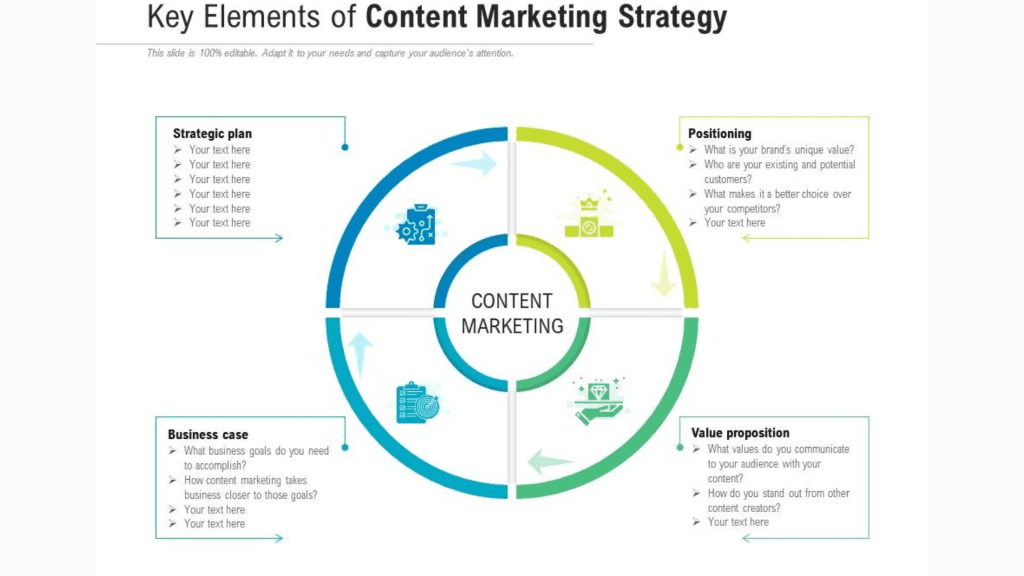In today’s digital age, content marketing has become a cornerstone of successful marketing strategies for businesses of all sizes and industries. It’s not just about creating content for the sake of it; it’s about building a strong content foundation that aligns with your business goals and engages your target audience. To achieve this, it’s essential to understand and implement the essential elements of a content marketing strategy. In this article, we’ll explore these key components and discuss how they can help you create a robust content marketing plan.

1. Clear Objectives and Goals:
A successful content marketing strategy begins with a clear understanding of what you aim to achieve. Your objectives should align with your overall business goals. Whether it’s increasing brand awareness, generating leads, boosting sales, or improving customer retention, defining your goals provides direction and purpose to your content efforts.
2. Audience Research and Persona Development:
Your audience is at the heart of your content strategy. To create content that resonates, you must understand your target audience inside out. Conduct thorough audience research to uncover their needs, pain points, preferences, and behaviors. Develop detailed audience personas to humanize your target demographic and guide content creation.
3. Content Planning and Strategy:
Once you have a clear understanding of your goals and audience, it’s time to plan your content strategy. This involves:
- Content Calendar: Create a content calendar outlining what content will be produced and when. A well-structured calendar ensures consistency and helps you stay organized.
- Content Types: Determine the types of content that will best serve your audience, such as blog posts, videos, infographics, podcasts, or eBooks.
- Content Themes: Identify key themes and topics that align with your brand and resonate with your audience’s interests and pain points.
4. High-Quality Content Creation
Quality is paramount in content marketing. Your content should be informative, engaging, and well-crafted. Prioritize quality over quantity. Consistently delivering valuable content builds trust and authority with your audience.
- Keyword Research: Incorporate keyword research to optimize your content for search engines and improve discoverability.
- Storytelling: Craft compelling narratives that connect with your audience on a personal level. Stories are powerful tools for conveying your brand’s values and messages.
- Visual Elements: Enhance your content with visually appealing elements, such as images, graphics, and videos. Visual content often garners higher engagement.
5. Content Distribution and Promotion
Creating great content is just the beginning; you must also ensure it reaches your target audience. Develop a distribution strategy that includes:
- Social Media Promotion: Share your content across relevant social media platforms to maximize its reach.
- Email Marketing: Utilize email campaigns to share content with your subscribers and nurture leads.
- Search Engine Optimization (SEO): Optimize your content for search engines to improve its visibility in search results.
- Paid Advertising: Consider using paid advertising to boost the reach of your content, especially when launching new campaigns or products.
6. Performance Tracking and Analytics
To gauge the effectiveness of your content marketing efforts, you need to measure and analyze performance metrics. Key performance indicators (KPIs) may include:
- Website Traffic: Monitor the number of visitors to your website and specific content pages.
- Conversion Rates: Track how many visitors take desired actions, such as signing up for a newsletter or making a purchase.
- Engagement Metrics: Analyze user engagement with your content, including likes, shares, comments, and time spent on-page.
- Return on Investment (ROI): Calculate the ROI of your content marketing efforts by comparing the costs of content creation and promotion to the revenue generated.
7. Iterate and Improve
A strong content marketing strategy is a dynamic one. Continuously evaluate your performance data to identify what’s working and what needs improvement. Adjust your strategy accordingly, and be open to experimenting with new content formats and distribution channels.
Building a strong content foundation is essential for success in the digital age. A well-thought-out content marketing strategy that aligns with your business goals, resonates with your audience, and provides high-quality content can be a powerful asset in achieving sustainable growth and building a strong brand presence. Remember that consistency, adaptability, and a commitment to delivering value to your audience are the keys to a successful content marketing strategy that stands the test of time.


